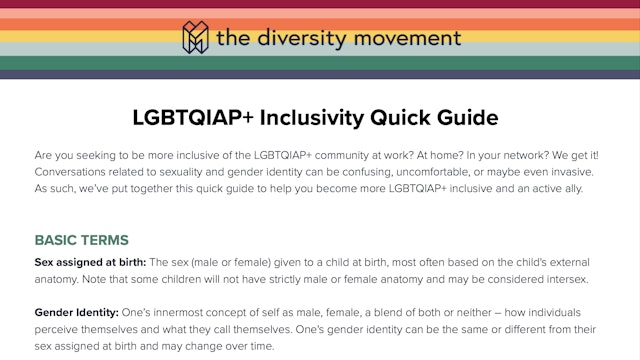-
How to Act as an Ally When a Coworker Comes Out
What’s the best way to be an effective ally when a colleague comes out to you at work? Here’s a sample role play conversation that will help you learn to be respectful and supportive. Feel comfortable and authentic in the moment by practicing ahead of time.
-
Is Intersex Considered a Gender?
Understand what intersex means, how it relates to gender, and why it would not be considered a gender identity.
-
What Do the Letters in LGBTQ+ Mean?
Confirm what each letter and symbol stands for in some commonly used acronyms, such as LGBTQ+, as a helpful starting point for recognizing and respecting human diversity in terms of sexual orientation and gender identity.
-
Do's and Dont's of Gender Inclusive Language
Benefit from this helpful list of best practice do’s and don’ts to ensure your workplace language is gender-inclusive, welcoming, and comfortable for everyone. Gain clarity on pronouns, specific words to use (or avoid), and the importance of keeping up-to-date as language evolves.
-
What is Gender Identity?
Consider how differently people are treated depending on whether they identify as a man, a woman, a person who is transgender or nonbinary, or another gender identity. By adding to your understanding of gender identities, you can better relate to and support others, no matter how they identify.
-
What to Say When a Coworker Tells You They’re Transgender
What should you say when a coworker tells you they’re transgender? Here is a sample role play conversation that will help you learn to be a good listener, trustworthy confidante, and supportive ally. Learn how to avoid one common pitfall.
-
Sexuality Terminology 101
Broaden your view of the many variations of human sexuality, identities, and orientations by absorbing the definitions of 23 different terms -- a list that is ever-evolving as certain terms are phased out of accepted usage and new terms are added.
-
5 Core Principles of Gender Identity Etiquette
Here are five helpful guidelines you can follow to affirm people across the gender spectrum. These insightful etiquette tips will help you to avoid making assumptions, be respectful, and develop into an effective ally for people of all gender identities.
-
LGBTQ Inclusivity Quick Guide
311 KB
-
History of the Pride Flag
Rainbow flags representing LGBTQ+ pride have become a common sight in many parts of the United States today, but how did they become such an important symbol in the first place? Here, we discuss how the 6-color rainbow flag came to be, and how it has evolved over the years to better represent the...
-
How Can I Be a Transgender Ally?
Take a reality check on violence against transgender people in the U.S., particularly Black transgender women. Learn how you can be a supportive transgender ally by using inclusive language, avoiding microaggressions, and educating yourself about the transgender experience.
-
How Do I Navigate When Someone Comes Out to Me as LGBTQ+ in the Workplace?
When someone comes out to you as LGBTQ+ you want to ensure you're not dismissive or overly congratulatory. Watch to learn a few things you shouldn't say as well as a script for getting this moment right.
-
Why You Should Honor Your Employees' Gender Pronouns
Consider that the pronouns people choose for themselves are as personal and unique to them as their names, and it’s easy to understand why it’s important to use your employees’ chosen gender pronouns in all communications. Learn to share your own gender pronouns in ways that empower you and others.
-
LGBTQ+ Allyship in the Classroom
Increase your know-how and get inspired by these tips for helping young people feel seen, safe, and heard throughout their school-age years. Learn how to effectively model and advocate for diversity and inclusion in schools and at home.
-
Gender Identity 101
Confirm the meaning of the term gender identity along with definitions of multiple terms people use to describe the particular gender identity personal to them. Get guidance on when, whether, and how to respectfully ask someone about their gender identity.
-
LGBTQ+ Inclusion is Good for Business
Learn how LGBTQ+ inclusion benefits organizations through employee engagement and productivity. For the full webinar, visit https://www.gotostage.com/channel/22238eff15284e69847a9bb5243d7217/recording/6d0801618afa4b2d9d4e6b2f226c81af/watch?source=CHANNEL
-
What is the Gender Binary?
Gain a broader perspective on gender beyond the binary -- the two traditional categories of man and woman. Learn more about people who consider themselves nonbinary, which can mean relating to both of these genders, neither, or a personal identify that’s somewhere in-between.
-
Understanding Sex, Gender Identity, and Sexual Orientation
Confirm your understanding of the terms sex, gender identity, and sexual orientation, and both the interplay and distinctions between the three. Learn when, whether, and how to discuss these self-identifying labels with others.
-
How Do I Make My Organization More Inclusive to Transgender People?
Get knowledgeable advice about steps you and your organization should take to ensure that your policies and practices are nondiscriminatory, inclusive, and supportive of transgender and gender nonconforming people. Learn to create a safe, stress-free work environment for employees in transition.
-
What Are Examples of Gender Pronouns?
Review this helpful list of commonly-used pronouns that people use to reference their personal gender identities. Confirm why using each person’s preferred pronouns is an important part of inclusive communication. Recognize the benefits of consistently sharing your preferred pronouns with others.
-
Is Gender a Spectrum?
In this video, we discuss the natural range of human genders that are often referred to as the gender spectrum. Learn more about what gender is, what it means to say gender is a spectrum (versus two binary categories) and how our understanding of gender has evolved along the way.
-
What is Coming Out?
Gain a better understanding of what it means to come out and how it’s a process that unfolds over time. Benefit from valuable tips on supporting LGBTQ+ inclusiveness in your organization, plus a short script that will help you to be a supportive, trustworthy ally when someone comes out to you.
-
What is the Difference Between Sexual Orientation and Gender Identity?
Recognize that there is a broad and nuanced spectrum of ways that individuals identify and define their personal sexual orientation, gender, and romantic attractions to others. Confirm the difference between sexual orientation and gender identity and review the definitions of commonly-used terms.
-
Navigating Challenges in the Workplace as a Nonbinary Employee
Learn about hurdles specific to nonbinary employees in the workplace.


























